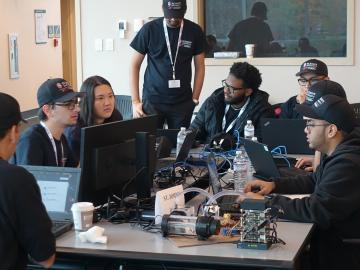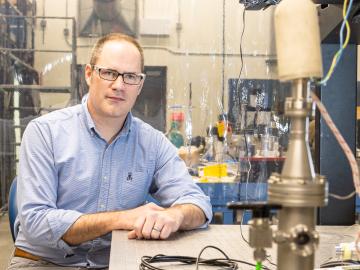
Filter News
Area of Research
- Advanced Manufacturing (2)
- Biology and Environment (7)
- Computational Biology (1)
- Computational Engineering (3)
- Computer Science (4)
- Energy Science (13)
- Fusion and Fission (6)
- Fusion Energy (4)
- Isotopes (2)
- Materials (10)
- Mathematics (1)
- National Security (9)
- Neutron Science (5)
- Nuclear Science and Technology (6)
- Quantum information Science (2)
- Supercomputing (23)
News Type
News Topics
- (-) Biomedical (10)
- (-) Clean Water (11)
- (-) Cybersecurity (15)
- (-) Frontier (10)
- (-) Machine Learning (10)
- (-) Nuclear Energy (19)
- (-) Summit (12)
- 3-D Printing/Advanced Manufacturing (38)
- Advanced Reactors (11)
- Artificial Intelligence (20)
- Big Data (12)
- Bioenergy (16)
- Biology (21)
- Biotechnology (3)
- Buildings (19)
- Chemical Sciences (16)
- Composites (11)
- Computer Science (51)
- Coronavirus (13)
- Critical Materials (8)
- Element Discovery (1)
- Energy Storage (40)
- Environment (38)
- Exascale Computing (5)
- Fossil Energy (1)
- Fusion (15)
- Grid (22)
- High-Performance Computing (17)
- Hydropower (5)
- Irradiation (1)
- Isotopes (10)
- ITER (4)
- Materials (54)
- Materials Science (42)
- Mathematics (1)
- Mercury (1)
- Microscopy (16)
- Molten Salt (1)
- Nanotechnology (17)
- National Security (13)
- Neutron Science (35)
- Partnerships (7)
- Physics (14)
- Polymers (9)
- Quantum Computing (6)
- Quantum Science (22)
- Security (5)
- Simulation (2)
- Space Exploration (10)
- Statistics (1)
- Transportation (30)
Media Contacts

A rare isotope in high demand for treating cancer is now more available to pharmaceutical companies developing and testing new drugs.

Scientists have found new, unexpected behaviors when SARS-CoV-2 – the virus that causes COVID-19 – encounters drugs known as inhibitors, which bind to certain components of the virus and block its ability to reproduce.

Researchers at Oak Ridge National Laboratory have identified a statistical relationship between the growth of cities and the spread of paved surfaces like roads and sidewalks. These impervious surfaces impede the flow of water into the ground, affecting the water cycle and, by extension, the climate.

Thirty-two Oak Ridge National Laboratory employees were named among teams recognized by former DOE Secretary Dan Brouillette with Secretary’s Honor Awards as he completed his term. Four teams received new awards that reflect DOE responses to the coronavirus pandemic.

Gina Tourassi has been appointed as director of the National Center for Computational Sciences, a division of the Computing and Computational Sciences Directorate at Oak Ridge National Laboratory.

As scientists study approaches to best sustain a fusion reactor, a team led by Oak Ridge National Laboratory investigated injecting shattered argon pellets into a super-hot plasma, when needed, to protect the reactor’s interior wall from high-energy runaway electrons.

The U.S. Department of Energy’s Office of Science announced allocations of supercomputer access to 47 science projects for 2020.

Oak Ridge National Laboratory will give college students the chance to practice cybersecurity skills in a real-world setting as a host of the Department of Energy’s fifth collegiate CyberForce Competition on Nov. 16. The event brings together student teams from across the country to compete at 10 of DOE’s national laboratories.

If humankind reaches Mars this century, an Oak Ridge National Laboratory-developed experiment testing advanced materials for spacecraft may play a key role.

Researchers at the Department of Energy’s Oak Ridge National Laboratory have received five 2019 R&D 100 Awards, increasing the lab’s total to 221 since the award’s inception in 1963.


